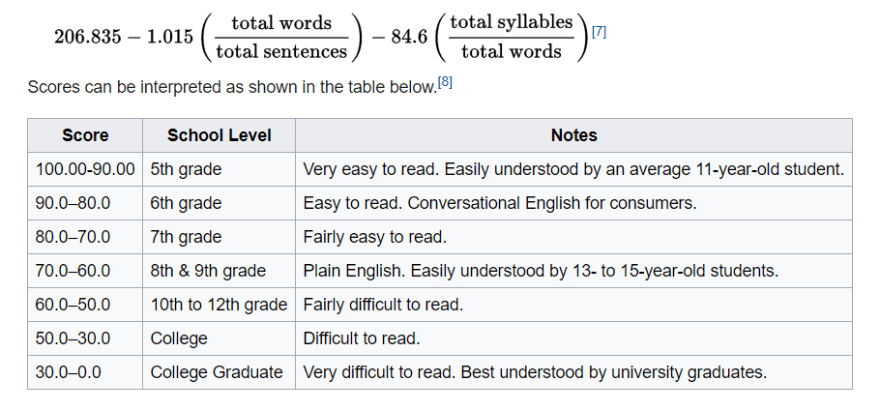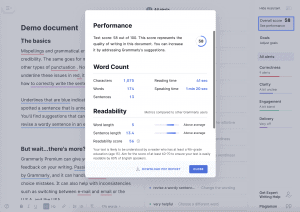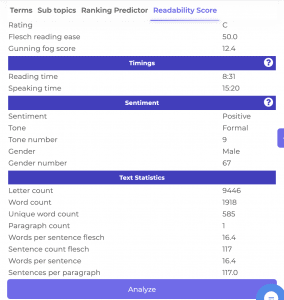Improve your SEO with a Readability Checker
- Home
- /
- Blog Posts
- /
- Improve your SEO with a Readability Checker
‘Readability’ is the concept of making your writing understandable and easy to digest.
Better readability can increase your site’s search engine optimization levels.
Even if your content contains valuable information, if it is hard to read, then no one will read it.
For example, I might find this article interesting, but if it is not readable (or easily understandable), then I will not bother to read it.
A good readability score is key to great SEO. The more readable your text, the more people are likely to read it.
There are many factors that contribute to readability, such as sentence length, sentence structure, and the average number of syllables per word.
The good news is that it’s easy to measure your website’s readability using a readability checker.
In this post, we’ll talk in detail about why readability is important in your SEO marketing strategy and how to measure it.
Why is readability an important step in your content marketing strategy?
If you want people to stay on your website long enough to read entire blog posts, and comprehend what they are reading, the content must be easy to understand.
Not only will this give you more return visitors and a higher conversion rate, but when your website’s content is clear to your targe audience, they will more easily learn about your product or service.
In turn, search engines will favor your website and rank it higher.
So, checking the readability score of a blog post is very important in order to ensure that your readers will love it.
You can improve it even before publishing so that you can get better content marketing performance.
Readability formulas, how they work, and what they can be used for.
Readability formulas are mathematical formulas for assessing the readability of text, usually by counting syllables, words, and sentences. It is often more efficient to use a definite readability test, instead of subjectively asking readers how easy it is to read the text.
Many word processing applications have in-built tests to evaluate the readability of a work.
As we mentioned before, many factors go into the ‘readability’ of a given text, like word and sentence length.
The more accurate the readability test is, the more you can use it on different documents.
Often, the final score is based on the average word length and sentence length.
The readability of a word, or a group of words, is decided by checking them against lists of graded words.
One such list that is commonly used is the Flesch Reading Ease formula, which includes a list of words graded for difficulty.
The scale compares the readability of words to the average reading level of American school children at different grade-levels.
Another common measure is the SMOG formula, which has a computerized readability program that incorporates an accurate syllable counter.
For Example: In order to address the fact that a word like “television” is well known to younger children but has many syllables, readability checker may include a list of words graded for difficulty.
However, simple word and sentence length measurements are more popular because they’re easier to compute.
Among the many readability formulas, the most common are the following five:
1- The Flesch Reading Ease and Flesch-Kincaid Grade Level Forumlas
The Flesch Reading Ease forumla, developed in the 1940s, is the most popular readability score.
This scoring system rates a text from 1 to 100, with 100 being the highest and equivalent to a school grade of 8.
A score of 70 to 80 means that the text should be fairly easy for the average adult to understand.
It is often used by marketers, research communicators and policy writers, among many others, to assess the ease by which a piece of text will be understood and engaged with.
What do the Flesch scores mean?
The Flesch Reading Ease Flesch score is between 1-100 and Flesch Kincaid Grade Level reflects the US education system.
The more readable a piece of content is, the lower the score.
They are both calculated with the same units, but the weightings for these units are different between the two tests, resulting in different readability scores.
The Flesch formula differs from other major readability scores, in that the higher the reading score, the easier text is to read.
Most other scoring formulas are the opposite, where the lower score is easier to read.
For example, in other formulas, a reading score of 60 to 70 is equivalent to an 8th grade level which means 13-15-year-olds can understand it.
Because of these differences, conversion tables are needed to help make sense of the Flesch Reading Ease score
How do the Flesch tests compare to other readability formulas?
The Flesch tests are the most well-established in readability tool ranging from marketing to government.
However, there are other formulas that are more specialized and better at specific tasks.
The Flesch Kincaid readability test is more suited for a general audience than as a formula for academic writing.
2-Gunning Fog Index
What is the Gunning Fog index and What is it used for?
The Gunning Fog formula estimates the level of education needed to read the text. A Gunning Fog score of 6 is easily readable by sixth-graders.

Text aimed at the general public should be at a grade level of around 8. Text above a 17 should be aimed at graduate-level readers.
The index was developed by Robert Gunning Associates, a company founded in 1944 by Robert Gunning to help businesses improve their writing.
In 1964, Gunning’s own work was judged for its complexity.
Columbia University evaluated his articles, and the results indicated that Gunning’s articles were too difficult to read.
Observations included “too many different words per thousand” and “too difficult for the intended audience.”
3-Coleman Liau Index
What is the Coleman-Liau Index?
The Coleman-Liau readability formula measures how reading difficulty by counting the sentences and letters.
It was first created in 1975 and now machines are able to calculate the formula.
The creators were looking for an alternative to syllabic counting techniques, which have difficulty detecting syllable changes when evaulating the readability of a text.
When is the test most useful? Is Coleman-Liau most useful for Western European texts?
If you’re using Coleman-Liau to compare those texts, the answer is yes.
However, the main disadvantage of Coleman-Liau is that it’s not standardized for use with other languages, and has some limitations when working with them.
For example: German is a complex language because it includes many compounded words.
German tenses can be harder to observe with Coleman-Liau, because it’s based on length in English.
However, the formula can be used to compare some aspects of German texts with English texts, like word length.
4-SMOG Index
What is a SMOG Index readability score?
The SMOG index estimates the years of education needed to understand a piece of writing.
SMOG is an acronym for “Simple Measure of Gobbledygook”. The SMOG rating will change depending on the length of the text you are testing, and is best used on texts with more than 30 sentences.
This was the length of text sampled in the creation of the formula.
Where did the index come from?
- Harry McLaughlin created the SMOG Index, which includes words with multiple syllables. He wanted to create a formula that could predict readability. To make it simple, he called his own formula “laughably simple.”
When is the SMOG Index most useful?
The SMOG Index is most useful for healthcare and other sectors where long and difficult words are typically used.
It measures the comprehensiveness and complexity of a text.
One study called SMOG the gold standard for assessing online Parkinson’s disease information, which was prompted by an increase in patients using the internet for health resources.
5-Automated Readability Index
What is the Automated Readability Index (ARI)?
The ARI assess how many characters are necessary to read a piece of text.
It is different from other formulas because it counts sentences rather than syllables. The more sentences there are, the harder it will be to read.
How was the test developed?
The Automated Readability Index (ARI) was designed for military use in 1967.
The ARI was for real-time monitoring of readability on typewriters.
It offered an automated counting method. This automated counting method has similar results to other frameworks, so we can trust in the accuracy of the ARI.
Reading Levels Explained:
Reading ‘on grade level’ means that an individual has learned the skills they need in order to read at the expected level of difficulty.
For instance, in kindergarten they could read words with simple patterns and words they often see (like “cat,” “hat,” and “hop”), and by third grade they could understand sentences that are 8-10 words long, and punctuation like commas and periods.
Which Grade level is suitable for Adult Readers?
There’s no definitive answer when it comes to understanding the reading levels of adults in America. Most estimates hover near 8th grade.
This equals 50% of the American adult population being unable to comprehend text that has been written at an 8th grade level.
Books that are often read by 8th graders include The Harry Potter series, Tom Clancy’s most recent works, John Grisham, and The Great Gatsby.
If your marketing copy is not at or below an 8th grade reading level, you are not communicating with a sizeable portion of your audience, unless your target audience is highly educated individuals.
ُThe importance of Grammar Checking in Readability
It is common for people to make mistakes in their writing, including professional writers. Even with the basics down, it can be hard to find higher-level grammar and style mistakes.

Grammarly is an app for writers that checks your work for spelling, grammar, and style errors. It also offers helpful tips to improve your writing.
The app is only available on certain platforms and doesn’t work offline. It is well worth the cost though, since it is easy to use and can fix many mistakes.
Plagiarism
Grammarly is a plagiarism-detection software that can catch anything copied off the internet. This is useful for students and professionals alike, including bloggers, freelance writers, editors and more.
Writing style
This will help you to edit and adapt your writing style as well. You will get immediate feedback on your readability score, word count, and grammar.
Is grammar sufficient for readability checking?
Grammarly is a great grammar checking tool, but they lack the data that’s really helpful to optimize your online campaigns.
Specifically, they don’t provide tools for sentiment checking, tone, or readability statistics. SimilarContent does provide these statistics, and it does so for free with their business and agency plans.
Conclusion
When writing for content marketing purposes, always inform, educate or entertain your audience.
Additionally, you should aim to keep your writing easy to read for your visitors.
An excellent tool to help you do this is the Readability Checker by SimilarContent.
.
